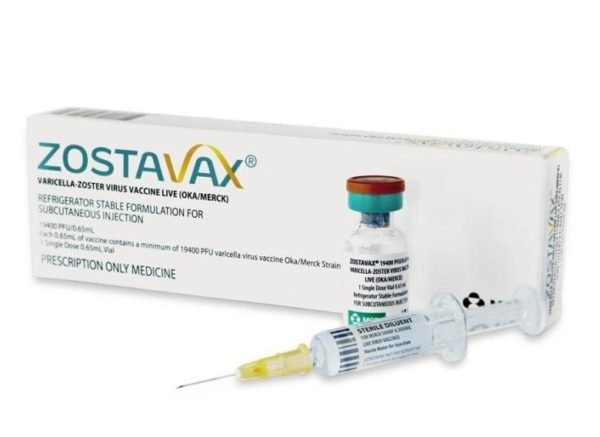A live attenuated vaccination is available for the shingles or herpes zoster virus. It is used to prevent herpes zoster (shingles) in patients who are immunocompetent and 50 years of age or older. In patients with active infections and individuals who have impaired immune systems, it should be avoided. Both the prevention of original varicella infection and the therapy of postherpetic neuralgia are not advised.
Shingles vaccine (herpes zoster vaccine) Dose in Adults
Dose in the prevention Shingles:
- Manufacturer labeling:
- Adults older than 50 years:
- 0.65 mL given subcutaneously in a single dose.
- Adults older than 50 years:
- ACIP recommendation:
- Adults older than 60 years:
- 0.65 mL given subcutaneously in a single dose.
- Adults older than 60 years:
Dosage adjustment in patients on concomitant chronic use of acyclovir, famciclovir, or valacyclovir:
- Before receiving the vaccine, patients should stop taking acyclovir, famciclovir, or valacyclovir for longer than 24 hours.
- Antiviral medications such as valacyclovir, famciclovir, and acyclovir shouldn't be taken within 14 days of receiving a shot.
Shingles vaccine (herpes zoster vaccine) Dose in Childrens
Not recommended in children.
Pregnancy Risk Category: X
- Shingles vaccine is a live attenuated vaccine that is contraindicated in pregnant patient.
- Patients of reproductive potential should be advised effective contraception.
- For three months following vaccination, pregnancy should be avoided.
- Congenital varicella syndrome cases should always be reported (in women exposed to the vaccine during pregnancy).
Shingles vaccine use during breastfeeding:
- Data regarding its excretion into the breastmilk is limited.
- The manufacturer recommends weighing the risks and benefits of vaccination.
Shingles vaccine (herpes zoster vaccine) Dose in Renal Disease:
- The manufacturer has not recommended any dose adjustment in patients with renal disease.
Shingles vaccine (herpes zoster vaccine) Dose in Liver Disease:
- The manufacturer has not recommended any dose adjustment in patients with liver disease.
Common Side Effects of shingles vaccine include:
- Local:
- Erythema at injection Site
- Localized Tenderness
- Swelling at injection Site
- Injection Site Pruritus
- Pain at the injection site
Less Common Side Effects of shingles vaccine include:
- Cardiovascular:
- Cardiac Failure
- Central Nervous System:
- Headache
- Gastrointestinal:
- Diarrhea
- Local:
- Induration at the injection Site
- Hematoma at the injection Site
- Warm Sensation at the injection Site
- Neuromuscular & Skeletal:
- Limb Pain
- Asthenia
- Respiratory:
- Respiratory Tract Disease
- Pulmonary Edema
Contraindication to shingles vaccine Include:
- Gelatin, neomycin, or any other vaccine component-related anaphylactic reaction
- Immunodeficiency or immunosuppression (primary or secondary as in patients with haematological malignancies like leukemia, lymphomas, and other malignant neoplasms that affect the bone marrow or the lymphatic systems, primary and acquired immunodeficiency states including AIDS, and patients receiving immunosuppressive therapy including those receiving high-dose corticosteroids).
- Pregnancy
- Active untreated tuberculosis.
- Patients on disease-modifying antirheumatic medications, especially anti-tumor necrosis factor medications like adalimumab, infliximab, and etanercept. Following the cessation of DMARDs by at least one month, vaccinations may be given.
- Patients undergoing hematopoietic stem cell transplant. If needed, administer 24 hours after transplantation.
- In addition to the patients listed above, the ACIP suggests avoiding the herpes zoster vaccine in the following category of patients.
- Patients with cellular immunodeficiency that is not specified except in patients with impaired humoral immunity.
Warnings & Precautions
- Anaphylaxis and allergic reactions:
- Serious allergic reactions and anaphylaxis may occur following vaccination.
- Immediate treatment including epinephrine should be available during vaccine use.
- Syncope:
- It has been documented that syncope that occurs right away (within 15 minutes of the immunisation) has the potential to cause catastrophic secondary injuries such skull fracture and cerebral haemorrhage.
- Patients should be seated to avoid syncope. Measures for resuscitation must be available at the bedside.
- Acute illness:
- Immunizations shouldn't be administered to patients who have moderate to severe infections, fever included.
- Vaccination in mild disease should not be delayed.
- Tuberculosis:
- The vaccination of patients with active, untreated tuberculosis is not advised.
- Zoster infection:
- For the treatment of an ongoing zoster outbreak, the vaccine is not advised.
- Until the patient is asymptomatic and over the acute stage of illness, vaccination should be postponed.
Monitor:
- Rash
- Fever
- Hypotension
How to administer shingles vaccine?
Subcutaneous administration:
- SubQ injections should be made into the deltoid area of the upper arm.
- Intravenous and Intramuscular administration should be avoided.
- It should be immediately injected after reconstitution and should not be mixed with other vaccines or injections.
- The vaccine should be administered while the patient is seated or lying down to avoid syncope.
Mechanism of action of Shingles vaccine (Herpes Zoster vaccine):
- The live attenuated shingles vaccination promotes active immunity against the herpes zoster virus.
- It lessens the occurrence and severity of sequelae, such as post-herpetic neuralgia after herpes zoster, as well as the development of herpes zoster.
- The incidence of zoster is decreased by the live zoster vaccine by around 70% in people aged 50 to 59, 64% in those aged 60 to 69, and 38% in people over the age of 70.
- Additionally, it lowers the risk of post-herpetic neuralgia by 5% in people 60 to 69 years old, 55% in people 70 to 79 years old, and 26% in those 80 years and beyond.
It takes around 6 weeks for it to start working, and the length of time that protection lasts gets shorter over time (with a substantial decrease after one year of vaccination).
International Brands of Shingles vaccine (herpes zoster vaccine):
- Zostavax
Shingles vaccine (herpes zoster vaccine) Brands in Pakistan:
- Okavax - Sanfi-aventis
- Varilrix - GSK
- Varivac - Changchun changsheng Life science/Hi-warble
- Vaxapox - Sind Medical Stores







